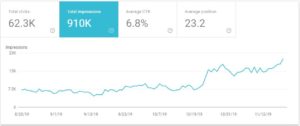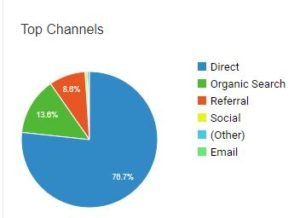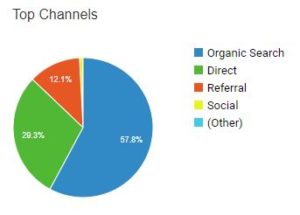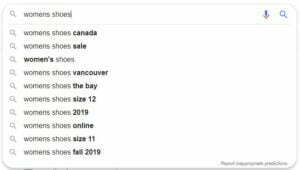Search Engine Optimization, more commonly known as, SEO can be very complicated. E-commerce SEO can be even trickier, mostly due to the significant amount of pages and what the structural complexity implies. Keeping up with current trends and requirements can be difficult and time-consuming. Our experts have put together this handy guide, so when you need a quick tip, you can find it with ease.
Our experts have gained experience in E-commerce SEO thanks to their time working on different types of E-commerce sites gaining knowledge that can help you along the way. Take a look at our E-commerce case study and see how we improve by 30% the revenue of our customer.
FREE VISIBILITY: if your SEO is properly done you website will appear more frequently on queries that are related and valuable for your company

FREE TRAFFIC: Some e-commerce website need massive investment in Ads to get traffic on their website, but why paying for this traffic when you can get it for free? Look one of our client stats: from 14% Organic Traffic to 58%!


LONG TERM CASH MACHINE: in opposition to paid search, display or shopping campaigns, SEO is a longer-term strategy. Once you get on the first page or the first results there is a high probability you will stay here for a while. Unless you stop your SEO efforts altogether.

Now you know why E-commerce SEO is so important let’s dive right in!
This article will talk through the main points of E-commerce SEO:
So, if you find yourself in need of a little extra help when trying to gain more traffic or growth online, be sure to keep this guide as a reference. To start, if you already have an E-commerce website you should do a technical audit and look for errors to start off fresh.
When you decide to take a look at your organization’s SEO, you may not know where to start. The best place to start is by having an SEO audit done and reading the content currently on your website.
What’s the most important? What steps have to be taken first? What are you and your content creators writing about?
By narrowing down the answer to those questions, you can figure out which aspects of your website needs more attention than others and which topics are relevant to your website and can help boost your overall SEO.
The act of searching your content and looking up keywords that relate to what your organization does or strives to do is conducting keyword research. While it may not seem like the most exciting part of the SEO process, it’s easily one of the most important. It serves as the base for all the other tactics you plan to implement. If you don’t have a strong keyword base to choose from, your content will fall flat in search engine result pages, or SERPs.
To make this part clearer for everyone, we will use the Shoes industry in this part.
According to your business type, there are different clusters of keywords you need to define.
A keyword is a word that is relevant to the content you are presenting. You want to select keywords that are not too generic as it will be more difficult to get a good ranking given the high number of websites relevant for those terms. For instance, if you were trying to rank for “shoes” you would find that it is a very common word which will trigger billions of results. In this situation, it would be better to craft a keyword that’s a bit more specific, while still directly relating to your own content. Let’s take the examples above as an example:
When there are less websites competing for a keyword, you will have more chances at getting your website ranked higher. You will be creating a list of potential search queries that are relevant to your business, mixing generic terms with more specific, long-tail keywords.
But how to select the right ones from here?
Every time a search engine user makes a query, he or she is doing so with specific intent.
When selecting keywords and topics for which you would like to improve the rankings of your website, you will need to identify what would be the user’s intent when making the query. Transactional terms are obviously the ones that have the higher potential to result in a purchase but you may also want to start appearing earlier in the customer’s buying process by selecting important informational intent keywords.
By taking the time to really get to know your own company and your target audience, you will find keywords with a higher ranking potential. And by understanding the intent behind the queries made by your potential customers, you will find that not only will your search engine rankings improve, but so will your sales. All of this goes hand-in-hand: if you were to skip the research process, you will likely be going after the wrong terms (competition is too high, not targeting enough transactional intent keywords…).
Now that you realize the importance of keyword research, it’s time to get started! There are many platforms that are designed to generate usable keywords, so you don’t have to come up with them all on the spot.
Notable resources include:




While Google Keyword Planner may seem like the only “official” keyword-generating platform out of this list, it’s actually not true! Google and Amazon suggestions along with Google auto-completion are great ways to find genuine searches. These will tell you exactly what customers or interested users are looking for, word for word.
By getting familiar with the language of your desired target market, you become more educated on how to craft messages for them both in SEO and other written content you present to them. At the end of the day, your content should be for your readers, not for search engines. If you use strong relatable keywords that users are looking for, you’ll find that it will positively affect the traffic to your site.
Once you have your keywords, it’s time to start shifting gears to your website architecture. This is the general makeup of your site and how it runs, specifically page by page. Search engines use “crawlers” which index your site and its corresponding pages. If a website is not set up to be optimized, pages can often be missed by these crawlers and miss be indexed, which will decrease traffic and lower rankings on SERPs.

To avoid this, make sure that your pages are not several clicks away from the homepage. It’s a good idea to have a link to just about every page you have right on the homepage, making them just one click away from the main website page. This will ensure they are indexed, yes, but it also helps your users navigate your page which will hopefully lead to them becoming repeat visitors.

On-page SEO is the act of optimizing web pages individually instead of looking at an entire website. The end goal of this is to boost higher and more relevant hits on search engines. It looks at both HTML source codes and the content itself, unlike off-page SEO.
Now that you have your site keywords and your website site architecture you can focus on-page SEO for your category and product pages, these pages are generating most of the traffic and sales.
The reasoning behind this is because these pages can be the ones to boost your overall rankings. Some E-commerce pages struggle because they are unable to rank for pages individually, especially if the product they are selling is available on other sites or pages.
A good way to fight against this, is to optimize your URL — make sure that your URL includes the main keywords your users are searching for so they can find your content easily.
Title Tag, make sure that all of your category pages are aptly titled. Another instance where you can benefit from that keyword research you did at the beginning of the process.
Don’t forget the META description! Optimizing them will directly affect how their description appears on search engine pages. Including call to action such as “Great Deals”, ” Largest Collection”, “Free Shipping”can improve significantly the click through rate form the Search Engine to your website.

If you have been using mostly off-page SEO tactics and they have been doing well, you may be wondering what the value of on-page SEO is. It’s pretty clear that you should have strong content regardless of whether you are utilizing on-page or off page, so the main reason is the HTML source codes. Ensuring that the source coding is as optimized as it can be is important because it plays a very strong role in your site’s overall ranking.
There are a few tactics that should be avoided because they do not follow the approved guidelines of search engines. These are often called “black hat tactics”. They are usually quick ways to improve a site’s SEO but they come at a cost. If a website is found to be using these unapproved tactics, they can be penalized by the search engines themselves, namely Google. Google enforces these guidelines regularly and does not shy away from removing a link from their rankings altogether. While your SEO may be boosted quickly, it will defeat the purpose if you get banned from search engines completely.
Alternatively, there are white hat SEO tactics that are search engine approved and should be the tactics you look to when you are revamping your site to increase traffic and ranking. Most of these will tell you to:
All of these will be sure to get your site in the right direction. These tactics may take a little longer than the black hat method, but it will ensure that you page will be able to remain in the good graces of search engines.
Last, but most definitely not least is technical SEO. This is what started it all and there’s a reason people use it — it works. There are numerous tactics that can be used to boost your site.
Here is a list of what we are looking for when we do technical SEO:
If you have a site that doesn’t run well or runs slowly, that will most likely affect your traffic. If Google or other search engines see users jumping ship quickly to navigate to another page on the same topic, they will think that another page is a better resource for the user, therefore granting them a better ranking.
Hopefully this guide and the tips provided will put you in the right direction and get you higher rankings more traffic on your site. By taking the time and putting in the work you will find that your site will thrive and will boost your business and your target audience’s faith in you and your work.